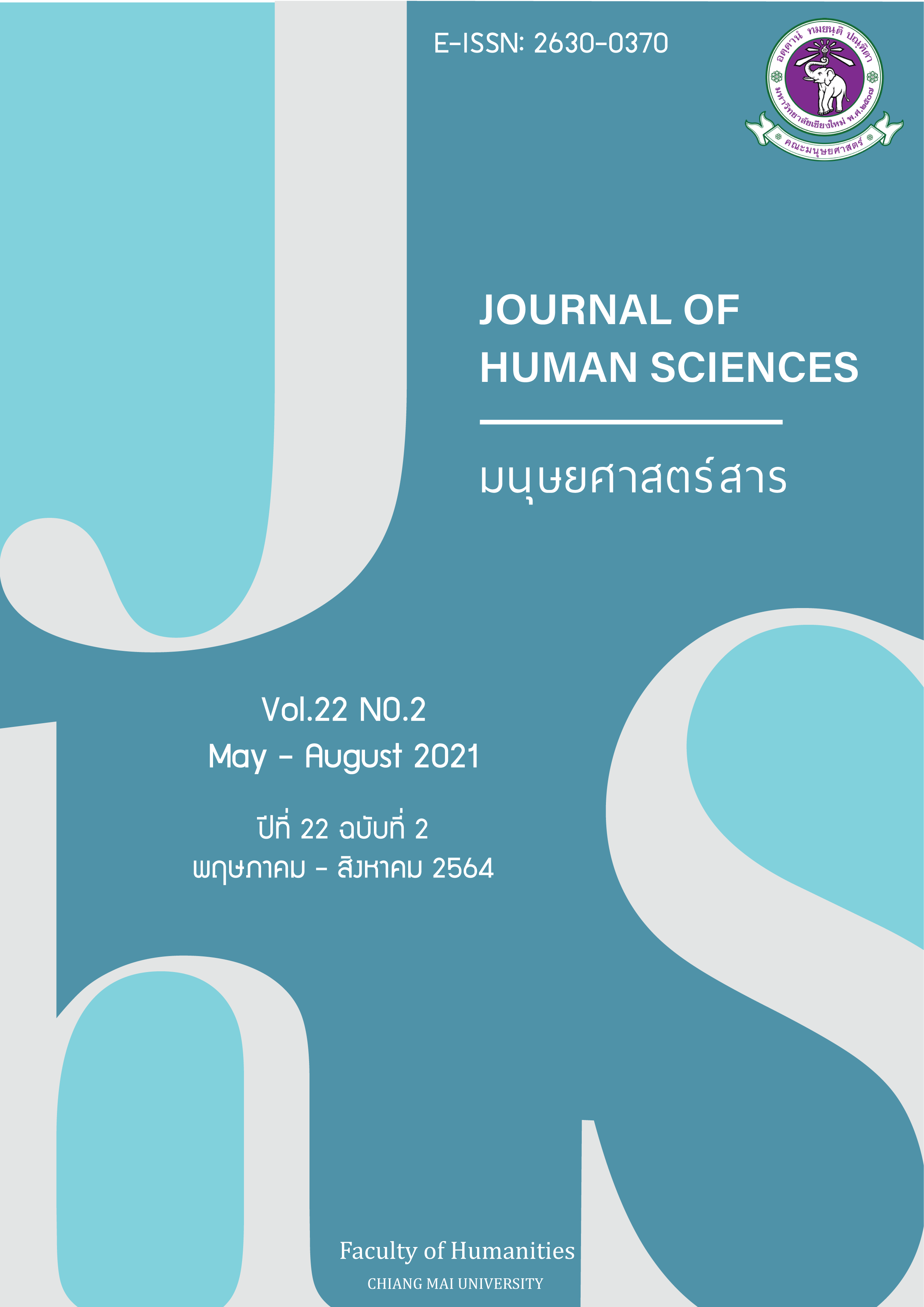กระบวนการทางจิตวิทยาในการย้ายถิ่นของคนเมืองกรุงสู่ชนบท
Main Article Content
บทคัดย่อ
การวิจัยครั้งนี้มีวัตถุประสงค์เพื่อศึกษาถึงกระบวนการจิตวิทยาในการย้ายถิ่นของคนเมืองกรุงสู่ชนบท ซึ่งเป็นการวิจัยเชิงคุณภาพแบบกรณีศึกษา โดยใช้การสัมภาษณ์เชิงลึกในการเก็บรวบรวมข้อมูล จากกลุ่มผู้ให้ข้อมูลที่เคยอาศัยประจำอยู่ในจังหวัดกรุงเทพฯ และย้ายออกมาอาศัยใช้ชีวิตอยู่ในพื้นที่ชนบทในประเทศไทย โดยการย้ายถิ่นเกิดขึ้นจากความสมัครใจ จำนวน 5 คน
ผลการวิจัยพบว่า กระบวนการทางจิตวิทยาในการย้ายถิ่น ประกอบด้วยประเด็นหลัก 3 ประเด็น ประเด็นที่หนึ่งคือ แรงจูงใจในการย้ายถิ่น ประกอบด้วยประเด็นรองคือ 1) การเปลี่ยนวิถีชีวิตของตนเอง 2) การเดินตามความฝัน 3) การพัฒนาชุมชน 4) ความสงบเรียบง่าย 5) ความเป็นอยู่ของกรุงเทพฯ 6) ความเป็นชนบท 7) ครอบครัว 8) การทำงาน 9) ภาพฝันที่ชัดเจน และ 10) ความพึงพอใจกับสภาพความเป็นอยู่ปัจจุบันที่มากกว่า ประเด็นที่สองคือ การปรับตัวในการย้ายถิ่น ประกอบด้วยประเด็นรองคือ 1) วิถีชีวิตที่แตกต่าง 2) สิ่งยึดเหนี่ยวสู่การก้าวผ่าน 3) งานใหม่ที่ไม่คุ้น 4) รูปแบบการใช้ชีวิตจากรายได้ที่ลดลง 5) ไม่ยึดติดปรับเปลี่ยนไปตามสถานการณ์ 6) การอยู่กับวัฒนธรรมความเชื่อที่แตกต่าง และ 7) สังคมแปลกหน้าไม่มีคนรู้จัก ประเด็นที่สามคือ สุขภาพจิตในกระบวนการย้ายถิ่น ประกอบด้วยประเด็นรองคือ 1) ความกล้าหาญ 2) การเตรียมความพร้อม 3) การสนับสนุนทางสังคม 4) กลไกการดูแลป้องกันความวิตกกังวล 5) ความยืดหยุ่นทนทาน 6) ความสุข 7) ความงอกงามภายในตน
Article Details
เอกสารอ้างอิง
Aldwin, C. M., & Levenson, M. R. (2004). Commentaries on Posttraumatic Growth: A Developmental Perspective. Psychological Inquiry, 15(1). 19–92.
Arsingsamanan, P. (2011). Influences of socio-economic factors upon rural-to-urban migration of workers. (Dissertation, Labour and Welfare Development, Thammasat University)
BBC. (n.d.). Urbanisation in MEDCs. Retrieved Aprill 4 2018, from www.bbc.co.uk/schools/ gcsebitesize/geography/urban_environments/urbanisation_medcs_rev1.shtml
Benson, M., & O'Reilly, K. (2009). Migration and the search for a better way of life: a critical exploration of lifestyle migration. The Sociological Review, 57(4). 608-625.
Bhugra, D. (2004). Migration and mental health. Acta Psychiatrica Scandinavica, 109(4). 243-258.
Brailovkaia, J., Schonfeld, P., Kochetkov, Y., & Margraf, J. (2019). What Does Migration Mean to Us? USA and Russia: Relationship Between Migration, Resilience, Social Support, Happiness, Life Satisfaction, Depression, Anxiety and Stress. Current Psychology, 38. 421-431
Calhoun, L. G., & Tedeschi, R. G. (2006). Handbook of posttraumatic growth: Research and Practice. Mahwah, NJ: Lawrence Erlbaum Associates.
Chalikruea, N. (2011). kan prap tua nai kanthamngan khong raengngan yai thin: sưksa chapho̜ korani khon ngan rongphayaban tamruat [การปรับตัวในการทำงานของแรงงานย้ายถิ่น: ศึกษาเฉพาะกรณีคนงานโรงพยาบาลตำรวจ]. Bangkok: Thammasat University
Chinophat, N. (1999). The way of life of Southerners residing in Bangkok. (Dissertation, Faculty of Sociology and Anthropology, Thammasat University)
Duangkaew, S. (2014). Lifestyle Migration of Japanese:A Case Study of Retired Japanese in Chiang Mai Province, Thailand. JSN Journal, 5(1). 35-52.
Ganjanapan, S. (2015). MAN AND THE MODERN WORLD. Retrieved from www.human.cmu.ac.th/
courseonline/huge/050104/page104.php
Haberkorn, G. (1981). The migration decision-making process: some social-psychological considerations. NY: Perganon Press.
Hawley, A.M. (1950). Human Ecology: A theory of community structure. NY: Ronald Press.
Lederbogen, F., Haddad, L., & Meyer-Lindenberg, A. (2013). Urban social stress – Risk factor for mental disorders : The case of schizophrenia. Environmental Pollution, 183, 2-6. Central Institute of Mental Health. University of Heidelberg.
Lyubomirsky, S., Tkach, C., & DiMatteo, M. R. (2006). What Are the Differences between Happiness and Self-Esteem. Social Indicators Research, 78. 363-404.
National Institute of Development Administration [NIDA]. (2012). Research Report Quality Life of Thai Population B.E.2555. Bangkok: Author.
Pan, J. Y., Wong, D. F. K., & Ye S. (2013). Post-migration Growth Scale for Chinese international students: Development and validation. Journal of Happiness Studies, 14. 1639-1655.
Phetkaew, P. (2006). Ethnic Mons migrant worker', s life adaptation: the case study of workers in rubber tree farming in Surathani Province. (Dissertation, Master of Art, Thammasat University)
Rogers, C. R. (1961). On becoming a person: a therapist's view of psychotherapy. Boston: Houghton Mifflin.
Stewart, M. J., Makwarimba, E., Beiser, M., Neufeld, A., Simich, L., & Spitzer, D. (2010). Social support and health: immigrants and refugees perspectives. Diversity & Equality in Health and Care. 7.
Stillman, S., McKenzie, D., Gibson, J. (2009). Migration and mental health: Evidence from a natural experiment. Journal of Health Economics, 28(3). 677-687.
Sutinyamanee, V. (2015). chak chonnabot su mưang: patchai thi mi itthiphon to lae phonkrathop chak kan yai thin [จากชนบทสู่เมือง: ปัจจัยที่มีอิทธิพลต่อและผลกระทบจากการย้ายถิ่น]. KASEM BUNDIT JOURNAL, 16(1). 102-112.
Tangchonlatip, K. (2007). Krung Thep Maha Nakhon: mưang to dieo talo̜t kan khong prathet Thai [กรุงเทพมหานคร: เมืองโตเดี่ยวตลอดกาลของประเทศไทย]. In Population and Social Research Nation Proceeding B.E. 2550. Nakorn Pathom: Institute for Population and Social Research, Mahidol University.
Traitrưngkoson, R. (1990). patchai thi mi phon to kan prap tua dan achip khong phu rap borikan chatha ngan: sưksa chapho korani sattri phak nưa sưng phan kan fưk oprom lae rap borikan chatha ngan chak krom prachasongkhro [ปจจัยที่มีผลตอการปรับตัวดานอาชีพของผูรับบริการจัดหางาน: ศึกษาเฉพาะกรณีสตรีภาคเหนือซึ่งผานการฝกอบรม และรับบริการจัดหางานทางกรมประชาสงเคราะห์]. (Dissertation, Faculty of Social Administration, Thammasat University)
Tseng, W. (2001). Handbook of cultural psychiatry. San Diego: Academic Press.
Tubtim, T. (2011). lukthung rư lukkrung?: khwampen mưang nai chonnabot Thai [ลูกทุ่งหรือลูกกรุง?: ความเป็นเมืองในชนบทไทย]. Journal of Sociology and Anthropology, 30(2). 137-154.
Van Dam, F., Heins, S., Elbersen, B.S. (2002). ‘Lay discourses of the rural and stated and revealed preferences for rural living. Some evidence of the existence of a rural idyll in the Netherlands’. Journal of Rural Studies, 18(4). 461-476.
Virupaksha, H.G., Kumar, A., & Nirmala, B.P. (2014). Migration and mental health: An interface. Journal of Natural Science, Biology and Medicine, 5(5). 223-239.
Wilson, G.A., Rigg J. (2003). ‘Post-productivist’ Agricultural regimes and the south: discordant concept?. Progress in Human Grography, 27(6). 681-707.


